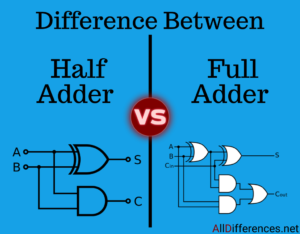Difference Between Half adder and Full adder
Contents
Difference Between Half adder and Full adder in Tabular Form
The Key Difference Between Half adder and Full adder is that Half adder has two inputs and Full adder has three inputs. Half adder is a combinational logic circuit.

Comparison Chart
| Half adder | Full adder |
|---|---|
| It is used for 2-bit addition. | It is used for 3-bit addition. |
| One Ex-OR gate and one AND gate are used. | One Ex-OR gate, three AND gates, and one OR gate are used. |
| Output is the sum of two signals. | Output is the sum of three signals. |
| Half adder circuit is simple. | Full adder circuit is complicated. |
| There are two input and two output terminals. | There are three input terminals and two output terminals. |
| It cannot be used as a full adder. | It can be used as a half adder. |
| Example: Calculators, computers, digital measuring devices, etc. | Example: Multiple bit addition, digital processors, etc. |
Half adder
- A Half adder has two binary bits.
- Block Diagram of Half adder.
 Half adder is two input terminals, which are marked as A and B.
Half adder is two input terminals, which are marked as A and B.- Half adder is two output terminal.
- One terminal is for sum bit S and the other is the carry bit C.
Full adder
- A half adder can add two bits.
- In addition of the second-bit carry signal from the first bit has to be added. So, half adder cannot be used. For this, a full adder circuit is used.

- In this, there are three input terminals. One input is Cin, which is carried from the previous stage. A & B are the two input terminals.
- There are two output terminals. One is the final sum S and the other is the final carry C.
